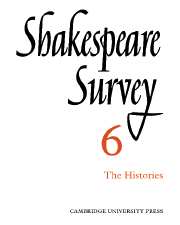Book contents
- Frontmatter
- Shakespeare's History plays: 1900-1951
- The Unity of 2 Henry IV
- Anticipation and Foreboding in Shakespeare’s Early Histories
- Middle-Class Attitudes in Shakespeare’s Histories
- A Reconsideration of Edward III
- On Producing Henry VI
- The Huntington Library
- An Early Elizabethan Playhouse
- Shakespeare Learns the Value of Money: The Dramatist at Work on Timon of Athens
- Shakespeare’s French Fruits
- An Elizabethan Eyewitness of Antony and Cleopatra?
- Othello’s “It is the cause . . .”: An Analysis
- On Translating Hamlet
- Shakespeare in China
- International Notes
- Shakespeare Productions in the United Kingdom: 1951
- Shakespeare’s History Plays - Epic or Drama?
- Festival Shakespeare in the West End
- The Year's Contributions to Shakespearian Study 1 Critical Studies
- 2 Shakespeare’s Life, Times and Stage
- 3 Textual Studies
- Books Received
- Index
- Plate Section
Shakespeare Learns the Value of Money: The Dramatist at Work on Timon of Athens
Published online by Cambridge University Press: 28 March 2007
- Frontmatter
- Shakespeare's History plays: 1900-1951
- The Unity of 2 Henry IV
- Anticipation and Foreboding in Shakespeare’s Early Histories
- Middle-Class Attitudes in Shakespeare’s Histories
- A Reconsideration of Edward III
- On Producing Henry VI
- The Huntington Library
- An Early Elizabethan Playhouse
- Shakespeare Learns the Value of Money: The Dramatist at Work on Timon of Athens
- Shakespeare’s French Fruits
- An Elizabethan Eyewitness of Antony and Cleopatra?
- Othello’s “It is the cause . . .”: An Analysis
- On Translating Hamlet
- Shakespeare in China
- International Notes
- Shakespeare Productions in the United Kingdom: 1951
- Shakespeare’s History Plays - Epic or Drama?
- Festival Shakespeare in the West End
- The Year's Contributions to Shakespearian Study 1 Critical Studies
- 2 Shakespeare’s Life, Times and Stage
- 3 Textual Studies
- Books Received
- Index
- Plate Section
Summary
Timon of Athens has for more than a century been the object of a good deal of speculation; and the workmanship of another hand was for long seen in the apparently weaker parts of the play. But several critics during the last two decades have endeavoured to show that there is more unity of theme and treatment in this play than was commonly supposed. Some of this very detailed analysis may be unconvincing, but most of the discussion has in recent years been concerned with deciding whether the play, as we have it, is in a finished or an unfinished state. Sir Edmund Chambers revived an old suggestion that the weakness of parts of the play was due to their being still in rough draft. That the play as printed in the Folio is in an incomplete state was likewise surmised by Sir Walter Greg, drawing particular attention to the stage-directions (“Some read almost more like directions for composition than production”); and Professor Una Ellis-Fermor has, on literary grounds, persuasively argued the same opinion.
This may be regarded as one of the most important outstanding problems of Shakespearian scholarship. If we could feel confident that the play is in part still in rough draft, then we should have a unique opportunity of getting close to Shakespeare's method of writing during the years of his greatest creative activity. We should be confirmed in our belief that he was a conscientious artist, prepared to correct and revise his work; and we could draw several interesting conclusions regarding his manner of constructing a play: that he put structure before composition, taking care, even in an early draft, to unify his play by means of ironic preparation and anticipation, symbolic contrast of plot and sub-plot, 'chorus-statements' by disinterested observers, iterative wx)rds, etc., but paying little attention, at first, to the characterization of minor personages and to the prose-verse form of the speeches.
- Type
- Chapter
- Information
- Shakespeare Survey , pp. 75 - 78Publisher: Cambridge University PressPrint publication year: 1953



